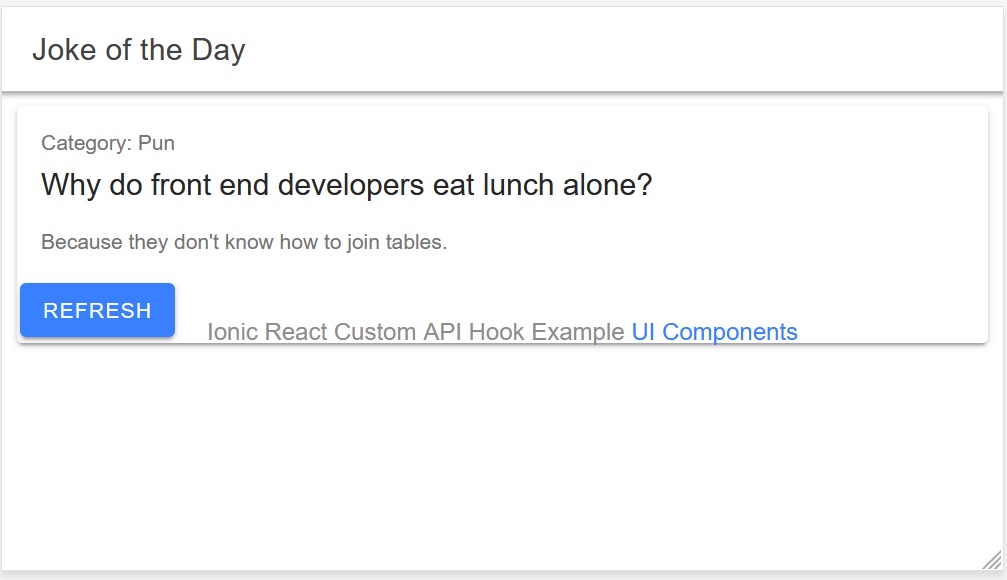- Forums
- ionic
- IONIC + React App - Fetch API Data with Custom Hook Example
This page is to show you how you can create a custom hook to fetch JSON data from an API. [4950], Last Updated: Mon Jun 24, 2024
edwin
Wed Sep 22, 2021
1 Comments
6756 Visits
Ionic + React - Custom Hook
In this page you will find the instructions to create a custom hook for your Ionic + React application. I will keep things very simple.
To start, lets start by creating an Ionic + React application. Open your terminal and send this command:
$ ionic start api_hook blank --type=react -capacitor --confirm --no-interactive
$ cd api_hook
I will be using VS Code, so open the project with VS Code:
$ code .
Add a file in the src/components/ directory. The file can be called useFetch.tsx and add the following code:
NOTICE: You will need axios for this example. to install is simple, just send this command: $ npm install axios
useFetch.tsx
import React, { useEffect, useState } from "react";
import axios from "axios";
function useFetch(url: any) {
const [data, setData] = useState<any>(null);
const [loading, setLoading] = useState(false);
const [error, setError] = useState(null);
useEffect(() => {
setLoading(true); // set loading to true
axios
.get(url)
.then((response) => {
setData(response.data);
})
.catch((err) => {
setError(err);
})
.finally(() => {
setLoading(false);
});
}, [url]);
// Function to call when button is clicked
const refetch = () => {
setLoading(true); // set loading to true
axios
.get(url)
.then((response) => {
setData(response.data);
})
.catch((err) => {
setError(err);
})
.finally(() => {
setLoading(false);
});
};
return { data, loading, error, refetch };
}
export default useFetch;
Now, open the src/components/exploreContainer.tsx file and make it look like this:
import "./ExploreContainer.css";
import useFetch from "../components/useFetch";
import {
IonPage,
IonHeader,
IonToolbar,
IonTitle,
IonContent,
IonCard,
IonCardHeader,
IonCardSubtitle,
IonCardTitle,
IonCardContent,
IonButton,
} from "@ionic/react";
const ExploreContainer: React.FC = () => {
const { data, refetch } = useFetch("https://v2.jokeapi.dev/joke/any");
if (!data) {
return <h1>Loading...</h1>;
} else {
console.log(data);
return (
<IonPage>
<IonHeader>
<IonToolbar>
<IonTitle>CardExamples</IonTitle>
</IonToolbar>
</IonHeader>
<IonContent>
<IonCard>
<IonCardHeader>
<IonCardSubtitle>Category: {data?.category}</IonCardSubtitle>
<IonCardTitle>{data?.setup}</IonCardTitle>
</IonCardHeader>
<IonCardContent>{data?.delivery}</IonCardContent>
<IonButton onClick={refetch}>Refresh</IonButton>
</IonCard>
<div className="container">
<p>
Ionic React Custom API Hook Example{" "}
<a
target="_blank"
rel="noopener noreferrer"
href="https://ionicframework.com/docs/components"
>
UI Components
</a>
</p>
</div>
</IonContent>
</IonPage>
);
}
};
export default ExploreContainer;
That is all the code you will need. You can now start the ionic server to look at the application to make a call to the joke api.
$ ionic serve
Hope that helps.
